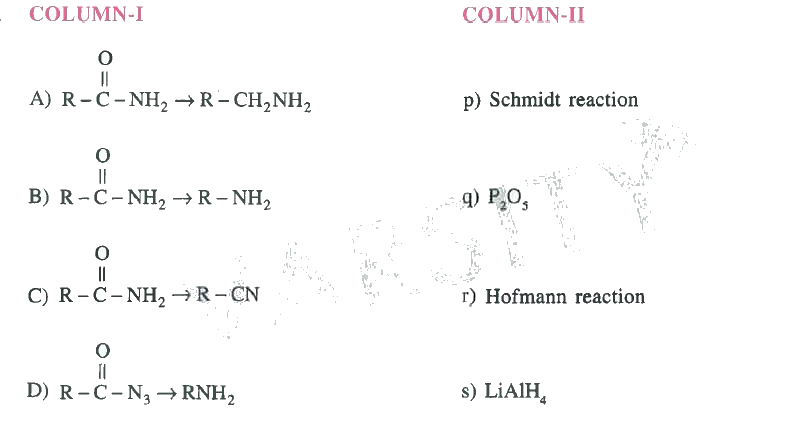There are some isomeric amines containing only one N atom. Each one of which forms a chloride salt on treatment with HCl containing 32.42% chlorine. None of them decolorizes Br2 water.
How many of them can evolve N2 on reaction with HNO2 ?Solution in Telugu
2
3
4
5
The correct Answer is:C
Step by step video, text & image solution for There are some isomeric amines containing only one N atom. Each one of which forms a chloride salt on treatment with HCl containing 32.42% chlorine. None of them decolorizes Br_(2) water. How many of them can evolve N_(2) on reaction with HNO_(2) ? by Chemistry experts to help you in doubts & scoring excellent marks in Class 12 exams.
Topper's Solved these Questions
- BOOK - AAKASH SERIESCHAPTER - AMINES AND AZO COMPOUNDS EXERCISE - PRACTICE SHEET - 5 (Linked Comprehension type questions)4videos
AMINES AND AZO COMPOUNDS
- BOOK - AAKASH SERIESCHAPTER - AMINES AND AZO COMPOUNDS EXERCISE - PRACTICE SHEET - 5 (Match the following questions)1videos
AMINES AND AZO COMPOUNDS
- BOOK - AAKASH SERIESCHAPTER - AMINES AND AZO COMPOUNDS EXERCISE - PRACTICE SHEET - 5 (Linked Comprehension type questions) Passage - I5videos
AMINES AND AZO COMPOUNDS
- BOOK - AAKASH SERIESCHAPTER - ALKYL AND ARYL HALIDESEXERCISE - OBJECTIVE EXERCISE - 4 (ASSERTION (A) & REASON (R) TYPE QUESTIONS)19videos
ALKYL AND ARYL HALIDES
- BOOK - AAKASH SERIESCHAPTER - AMINES AND DIAZONIUM SLATSEXERCISE - PRACTICE EXERCISE25videos
AMINES AND DIAZONIUM SLATS
Similar Questions
There are some isomeric amines containing only one N atom. Each one of which forms a chloride salt on treatment with HCl containing 32.42% chlorine. None of them decolorizes Br2 water.
How many of them contains chiral carbon ?10:26View SolutionMatch the following columns
 10:26View Solution
10:26View SolutionAmines are less reactive in substitution reactions. Their reactivity is much lesser than alcohols and alkylflourides towards substitution. Protonation of the amino group makes it a better leaving group, but not nearly as good a leaving group as a protonated alcohol. Protonated amino groups cannot be displaced by OH− because it would react immediately with the acidic hydrogen which would convert it in to a poor nucleophile.
The leaving group in quartenary ammonium ion has about the same leaving tendency as a protonated amino group but does not have acidic hydrogen. The reaction of a quartenary ammonium ion with hydroxide ion is known as Hoffmann elimination reaction. The leaving group is tertiary amine. Since a tertiary amine is only a moderately good leaving group, the reaction requires heat. The carbon to which the tertiary amine is attached is designated as α carbon.
When the hydroxide ion starts to remove a β H from a quartenary ammonium ion, the leaving group does not immediately start to leave because a tertiary amine is not a good leaving group. As a result, a partial negative charge builds up on the carbon from which the proton is removed.
Which of the following statements is correct?10:26View Solution(A) Towards SN2 reaction, order of reactivity is CH3Br>CH3CH2Br>(CH3)2CHBr>(CH3)3CBr.
(R) Greater the stability of carbocation, greater will be its ease of formation from alkyl halide and faster will be the rate of SN1 reaction.10:26View SolutionIUPAC name of (C2H5)3C−NH2 is
10:26View Solution[A],[B],[C],[D],[E],[F],and [G] are amines,each of which forms a hydrochloride containing 32.42%chloride.[A],[B],[C]and,[D]evoleN2on reaction with HNO2but [E],[F],and[G]donot.
Which of the following are1∘amines?10:26View Solution[A],[B],[C],[D],[E],[F] ,and [G] are amines,each of which forms a hydrochloride containing 32.42% chloride. [A],[B],[C] and, [D] evole N_(2) on reaction with HNO_(2) but [E],[F] ,and [G] donot. Which of the following are 2^(@) amines?
10:26View Solution[A],[B],[C],[D],[E],[F] ,and [G] are amines,each of which forms a hydrochloride containing 32.42% chloride. [A],[B],[C] and, [D] evole N_(2) on reaction with HNO_(2) but [E],[F] ,and [G] donot. If all the amines aree represented by the formula R-NH_(2) , the value of R in all the amines is:
View Solution[A],[B],[C],[D],[E],[F] ,and [G] are amines,each of which forms a hydrochloride containing 32.42% chloride. [A],[B],[C] and, [D] evole N_(2) on reaction with HNO_(2) but [E],[F] ,and [G] donot. Which of the following does not represent the structure of (A),(B),(C), and (D)?
View Solution[A],[b],[C],[D],[E],[F] ,and[G] are amines,each of which forms a hydrochloride containing 32.42% chloride. [A],[B],[C] and,[D]evole N_(2) on reaction with HNO_(2) but [E],[F],and[G] do not. Which of the following does not represent the structure of (E),)F), and (G)?
View Solution[A],[b],[C],[D],[E],[F],and[G] are amines,each of which forms a hydrochloride containing 32.42%chloride.[A],[B],[C]and,[D]evoleN2on reaction with HNO2but [E],[F],and[G]do¬.<br>Whichofthefollow∈ggivesalcoholandevolvesN_(2) gas?
01:24View Solution[A],[b],[C],[D],[E],[F],and[G] are amines,each of which forms a hydrochloride containing 32.42%chloride.[A],[B],[C]and,[D]evoleN2on reaction with HNO2but [E],[F],and[G]donot.
02:45View SolutionThere are some isomeric amines containing only one N atom. Each one of which forms a chloride salt on treatment with HCl containing 32.42% chlorine. None of them decolorizes Br_2 water. How many of them can evolve N_2 on reaction with HNO_2 ?
02:16View SolutionThere are some isomeric amines containing only one N atom. Each one of which forms a chloride salt on treatment with HCl containing 32.42% chlorine. None of them decolorizes Br_2 water. How many of them contains chiral carbon?
02:16View SolutionThere are some isomeric amines containing only one N atom. Each one of which forms a chloride salt on treatment with HCl containing 32.42% chlorine. None of them decolorizes Br_2 water. How many of them does not give carbyl amine test?
03:06View Solution

